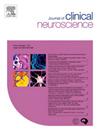Hemoglobin decline within 24 h post-mechanical thrombectomy as an indicator of poor clinical outcomes
IF 1.8
4区 医学
Q3 CLINICAL NEUROLOGY
引用次数: 0
Abstract
Background
Mechanical thrombectomy (MT) for acute large vessel occlusion (LVO) significantly improves patient prognosis. However, despite successful recanalization achieved through MT, some patients still have unfavorable outcomes. Although anemia in the context of ischemic stroke is recognized as a detrimental prognostic factor, its impact on patients undergoing MT remains inconclusive. Post-MT anemia is frequently a target of intervention, but its prevention is of greater importance. We investigated the extent of hemoglobin (Hb) reduction after MT for acute LVO, its impact on prognosis, and potential preventive strategies.
Methods
The study included 102 patients who underwent MT between January 2016 and December 2022. Hb levels were monitored from admission until day 10 post-MT. We collected data on age, sex, weight, cause of ischemic stroke, location of vessel occlusion, and details regarding MT. The administration of recombinant tissue plasminogen activator, pre-stroke antithrombotic therapy, National Institutes of Health Stroke Scale (NIHSS) score, and presence of chronic kidney disease or chronic heart failure were also recorded. The modified Rankin Scale (mRS) score was assessed on admission and at 3 months follow-up. Factors associated with mRS scores of 3–6 at 3 months were identified.
Results
The highest Hb decrease was noted from admission to 24 h post-MT, with the median Hb level reaching its lowest point on day 4. Poor prognosis was associated with mRS score on admission (odds ratio [OR], 6.94; 95% confidence interval [CI], 1.28–37.60), NIHSS score (OR, 1.14; 95% CI, 1.04–1.25), modified thrombolysis in cerebral infarction 2c–3 recanalization (OR, 0.16; 95% CI, 0.03–0.73), and Hb decrease 24 h post-MT (OR, 2.17; 95% CI, 1.07–4.43). Hb decrease 24 h post-MT was significantly associated with more than two device passes (p-value, 0.037).
Conclusions
A decrease in Hb 24 h post-MT was associated with a negative prognosis, with a decrease in Hb being linked to more than two device passes. Efforts should be directed toward optimizing the first-pass effect in MT to enhance procedural efficacy and clinical outcomes.
机械取栓后24小时内血红蛋白下降作为临床预后不良的指标
背景:机械取栓(MT)治疗急性大血管闭塞(LVO)可显著改善患者预后。然而,尽管通过MT实现了成功的再通,一些患者仍然有不良的结果。尽管缺血性卒中背景下的贫血被认为是一个有害的预后因素,但其对MT患者的影响仍不确定。mt后贫血经常是干预的目标,但其预防更为重要。我们研究了急性LVO MT后血红蛋白(Hb)减少的程度,其对预后的影响,以及潜在的预防策略。方法本研究纳入了2016年1月至2022年12月期间接受MT治疗的102例患者。从入院到mt后第10天监测Hb水平。我们收集了年龄、性别、体重、缺血性卒中的原因、血管闭塞的位置和MT的详细信息。重组组织纤溶酶原激活剂的使用、卒中前抗血栓治疗、美国国立卫生研究院卒中量表(NIHSS)评分、慢性肾脏疾病或慢性心力衰竭的存在也被记录下来。于入院时及随访3个月时评估改良Rankin量表(mRS)评分。确定与3个月mRS评分3 - 6相关的因素。结果从入院到mt后24小时Hb下降幅度最大,Hb水平中位数在第4天达到最低点。预后不良与入院时mRS评分相关(优势比[OR], 6.94;95%可信区间[CI], 1.28-37.60), NIHSS评分(OR, 1.14;95% CI, 1.04-1.25),改良溶栓治疗脑梗死2c-3再通(OR, 0.16;95% CI, 0.03-0.73), mt后24 h Hb下降(OR, 2.17;95% ci, 1.07-4.43)。mt后24小时Hb下降与两次以上器械传递显著相关(p值,0.037)。结论:移植后24小时Hb下降与不良预后相关,Hb下降与两次以上器械通过有关。应努力优化MT的首过效应,以提高手术疗效和临床结果。
本文章由计算机程序翻译,如有差异,请以英文原文为准。
求助全文
约1分钟内获得全文
求助全文
来源期刊

Journal of Clinical Neuroscience
医学-临床神经学
CiteScore
4.50
自引率
0.00%
发文量
402
审稿时长
40 days
期刊介绍:
This International journal, Journal of Clinical Neuroscience, publishes articles on clinical neurosurgery and neurology and the related neurosciences such as neuro-pathology, neuro-radiology, neuro-ophthalmology and neuro-physiology.
The journal has a broad International perspective, and emphasises the advances occurring in Asia, the Pacific Rim region, Europe and North America. The Journal acts as a focus for publication of major clinical and laboratory research, as well as publishing solicited manuscripts on specific subjects from experts, case reports and other information of interest to clinicians working in the clinical neurosciences.
 求助内容:
求助内容: 应助结果提醒方式:
应助结果提醒方式:


